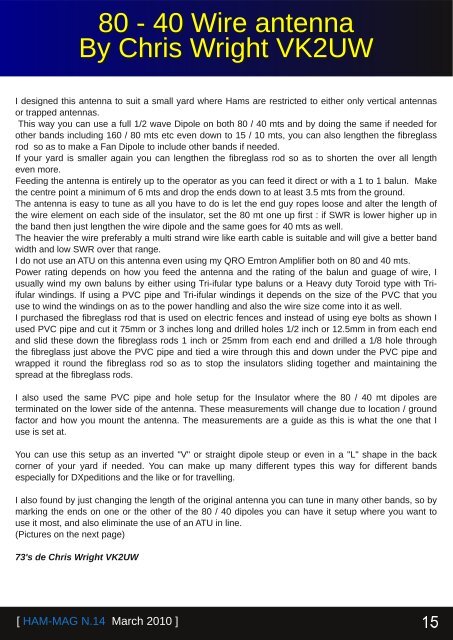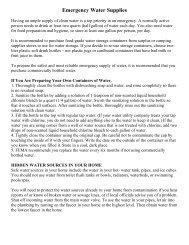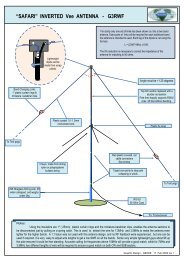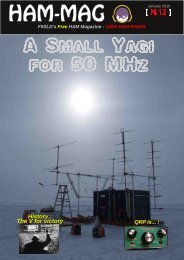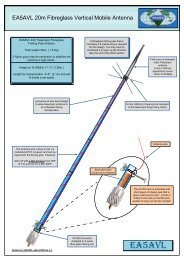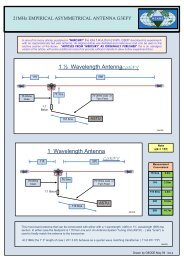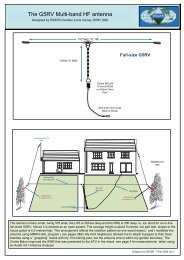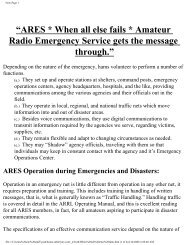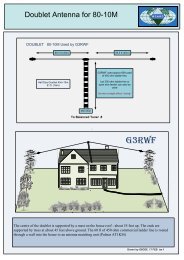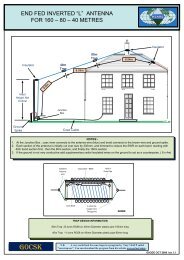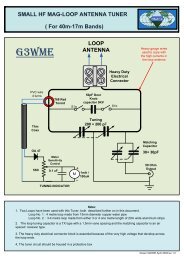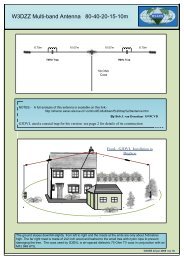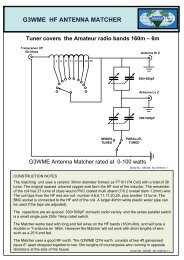Inernational HAM Magazine 100% HAM RADIO - arkansas ares races
Inernational HAM Magazine 100% HAM RADIO - arkansas ares races
Inernational HAM Magazine 100% HAM RADIO - arkansas ares races
You also want an ePaper? Increase the reach of your titles
YUMPU automatically turns print PDFs into web optimized ePapers that Google loves.
80 40 Wire antenna<br />
By Chris Wright VK2UW<br />
I designed this antenna to suit a small yard where Hams are restricted to either only vertical antennas<br />
or trapped antennas.<br />
This way you can use a full 1/2 wave Dipole on both 80 / 40 mts and by doing the same if needed for<br />
other bands including 160 / 80 mts etc even down to 15 / 10 mts, you can also lengthen the fibreglass<br />
rod so as to make a Fan Dipole to include other bands if needed.<br />
If your yard is smaller again you can lengthen the fibreglass rod so as to shorten the over all length<br />
even more.<br />
Feeding the antenna is entirely up to the operator as you can feed it direct or with a 1 to 1 balun. Make<br />
the centre point a minimum of 6 mts and drop the ends down to at least 3.5 mts from the ground.<br />
The antenna is easy to tune as all you have to do is let the end guy ropes loose and alter the length of<br />
the wire element on each side of the insulator, set the 80 mt one up first : if SWR is lower higher up in<br />
the band then just lengthen the wire dipole and the same goes for 40 mts as well.<br />
The heavier the wire preferably a multi strand wire like earth cable is suitable and will give a better band<br />
width and low SWR over that range.<br />
I do not use an ATU on this antenna even using my QRO Emtron Amplifier both on 80 and 40 mts.<br />
Power rating depends on how you feed the antenna and the rating of the balun and guage of wire, I<br />
usually wind my own baluns by either using Triifular type baluns or a Heavy duty Toroid type with Triifular<br />
windings. If using a PVC pipe and Triifular windings it depends on the size of the PVC that you<br />
use to wind the windings on as to the power handling and also the wire size come into it as well.<br />
I purchased the fibreglass rod that is used on electric fences and instead of using eye bolts as shown I<br />
used PVC pipe and cut it 75mm or 3 inches long and drilled holes 1/2 inch or 12.5mm in from each end<br />
and slid these down the fibreglass rods 1 inch or 25mm from each end and drilled a 1/8 hole through<br />
the fibreglass just above the PVC pipe and tied a wire through this and down under the PVC pipe and<br />
wrapped it round the fibreglass rod so as to stop the insulators sliding together and maintaining the<br />
spread at the fibreglass rods.<br />
I also used the same PVC pipe and hole setup for the Insulator where the 80 / 40 mt dipoles are<br />
terminated on the lower side of the antenna. These measurements will change due to location / ground<br />
factor and how you mount the antenna. The measurements are a guide as this is what the one that I<br />
use is set at.<br />
You can use this setup as an inverted "V" or straight dipole steup or even in a "L" shape in the back<br />
corner of your yard if needed. You can make up many different types this way for different bands<br />
especially for DXpeditions and the like or for travelling.<br />
I also found by just changing the length of the original antenna you can tune in many other bands, so by<br />
marking the ends on one or the other of the 80 / 40 dipoles you can have it setup where you want to<br />
use it most, and also eliminate the use of an ATU in line.<br />
(Pictures on the next page)<br />
73's de Chris Wright VK2UW<br />
[ <strong>HAM</strong>MAG N.14 March 2010 ]


